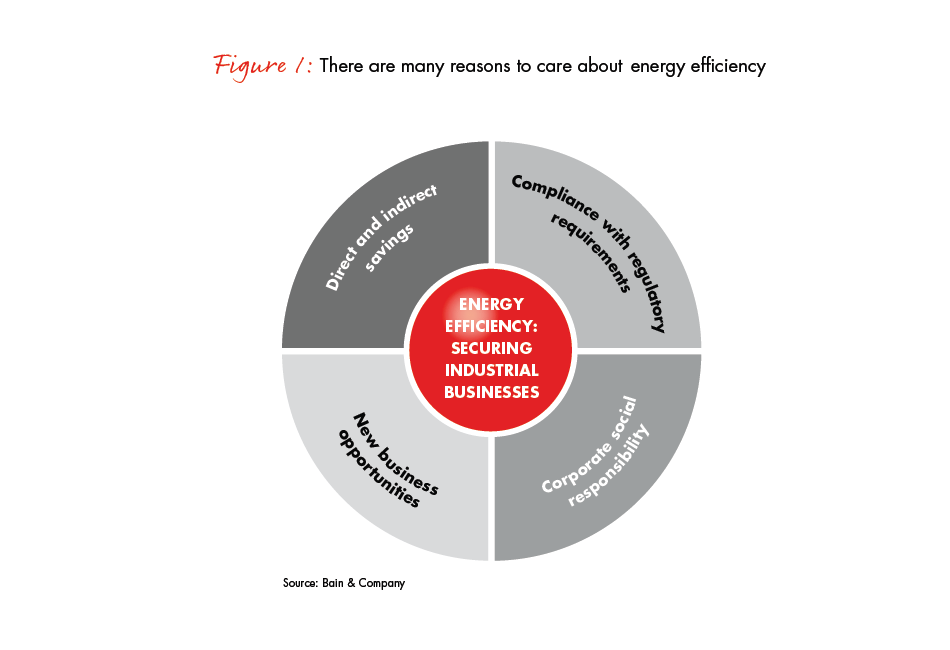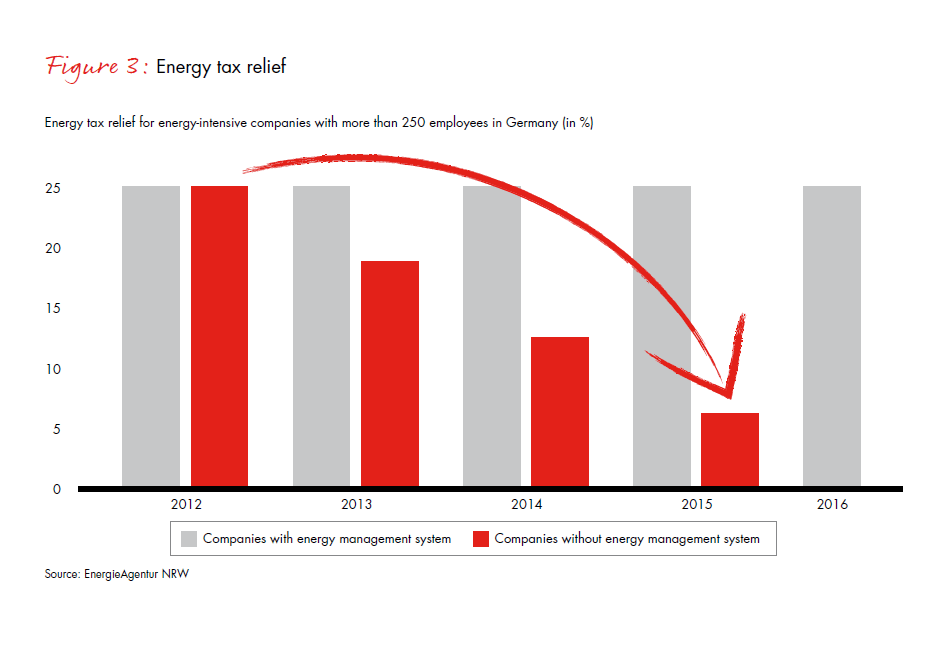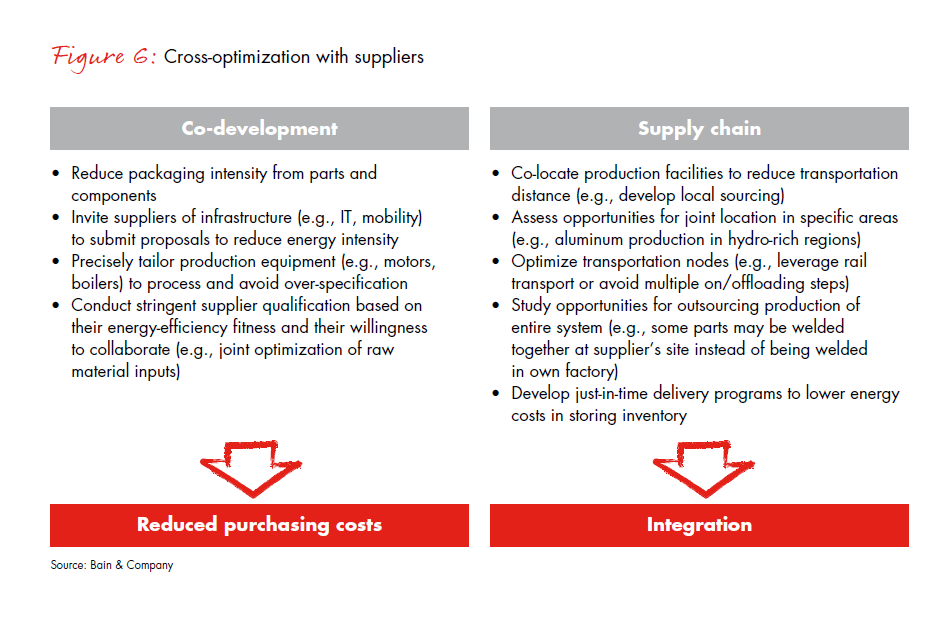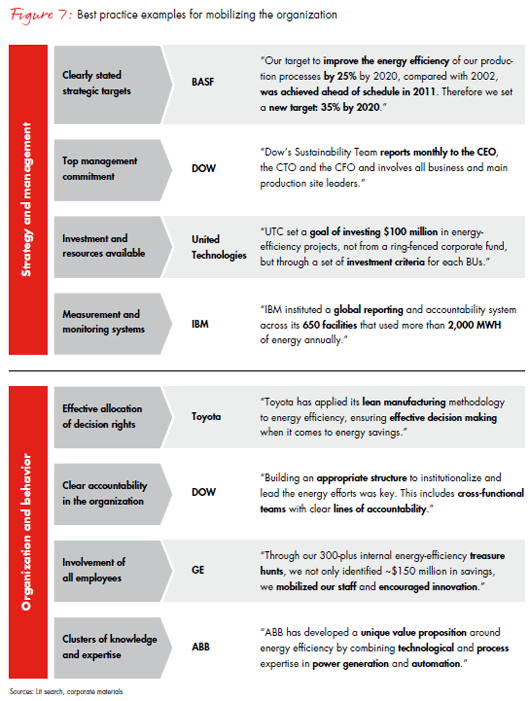Brief
Executive Summary
CEOs often ask us what they can do about energy efficiency. Most feel that they need to act on the topic—80% of respondents to a 2010 Economist Intelligence Unit survey agreed that energy efficiency is becoming more important—but only half said their companies were doing enough to integrate efficiency into their business strategy.
At Bain, we believe that energy-efficiency programs significantly improve the sustainability, economic stability and image of an industrial or consumer goods manufacturing company.
Some corporations in energy-intensive industries have been tackling the subject for a while. Dow Chemical Company, an early adherent, says it has saved $24 billion since launching its energy-efficiency program in the 1990s. BASF, GE and Toyota claim similar benefits. Talking with these and other companies reveals a wide range of benefits beyond direct energy savings.
Bain’s research and project experience show that a typical manufacturing company in Europe or North America can save between 10% and 30% of direct energy costs in three years. Indirect savings, like reduced maintenance, materials and waste, as well as lower risks, typically add another 50% on top of the direct energy cost reductions.
Beyond these savings, energy efficiency delivers benefits around corporate social responsibility, employee motivation, improved sustainability and a secure base of economic activity. Depending on the respective products and value chain position, energy-efficiency products and energy-efficiency services can also make for improved offers and even new business models.
Energy efficiency is an option today, but it’s likely to be a necessity very soon. Few manufacturers can pass up the opportunity to improve profitability by 2%, mobilize their employees or ignore new business opportunities. We believe energy-efficiency programs will play an important part in keeping European and US manufacturing competitive over the next decade. While the regulatory environment is still in the making, the pure business logic is already convincing today.
1. A wide range of benefits, and a “must”
Most manufacturing executives think of energy efficiency only in terms of cost savings. They scrap old, energy-guzzling equipment and think they did a good job. In truth, they did only half the job, because energy efficiency offers much more. It can reduce non-energy costs, for example, create new business opportunities, significantly improve the company’s image for all stakeholders and help companies stay competitive and attractive to customers (see Figure 1). In order to reach its full potential, an energy-efficiency program must cover the whole value chain, from sourcing to selling.
A complete energy-efficiency program combines several aspects. It is a preemptive move to meet impending regulations. It answers concerns from the board of directors on improving the resilience of the company. It addresses future needs of customers. And, it strengthens company culture by enhancing energy sustainability. Of course, energy efficiency cannot be achieved through a onetime improvement. Instead, it needs a holistic and ongoing initiative that gets institutionalized within the company—much like quality management, with which it shares many goals.

Substantial direct and indirect savings
Energy is one of the few remaining opportunities to reduce costs in manufacturing. Energy accounts for about 5% of costs for an average manufacturing company, more in energy-intensive industries. An energy-efficiency program can save between 10% and 30% of those energy costs within three years. Indirect savings from reduced maintenance, materials, waste and risk increase the benefits, combining to effectively cut direct energy costs by about half. Tax reductions and government incentives boost the savings further in many countries. Most savings come from adapting equipment and processes. In production, typical efficiency measures include more effective motors, drives, boilers, furnaces, pumps, compressors, and ventilation and heating systems. Energy recovery systems can help reduce demand. On-site generation can also reduce costs, and, in some places, manufacturers can sell power back to the grid when they produce more energy than they use. A plan to use energy flexibly, reducing usage during peak times, saves even more.
Bain’s calculations show that the average manufacturing company can improve its profit margin by 2% within three years, helping to strengthen industrial players and maintain Europe and the US as strong manufacturing centers (see Figure 2).

Compliance with tightening regulatory requirements
EU directives aim to reduce energy consumption by 1.5% annually between 2014 and 2020, so most organizations will need to implement energy-efficiency programs to ensure compliance. Energy management at large companies will be audited every four years, and several current ministerial draft bills indicate that simplified procedures are planned for small and medium-sized enterprises. National rules concretely implementing the EU’s plans are to be applied by June 2014.
Germany introduced an energy tax (the “eco-tax”) in 1999 to encourage energy savings in the private, public and commercial sectors. To lessen the impact on manufacturing companies, which were hit hardest by the new tax, German lawmakers also introduced a tax relief—as high as 90% for energy-intensive production processes like steel or cement production. Over the years, some 100,000 German companies had benefited from these tax incentives in varying degrees. However, starting in 2013, only companies that implement energy-efficiency management systems in line with ISO 50001/EN 16001 certification and meet annual energy-savings targets are eligible for them. As of today, less than 20% of German and Swiss industrial firms with more than 250 employees have that certification, and many do not yet meet the requirements (see Figure 3).

Switzerland’s Energy Strategy 2050 framework proposes similar measures with compulsory efficiency targets and sanctions for companies that miss them. Meeting energy-efficiency standards will become a prerequisite for participating in public tenders. Energy inspections will help reduce consumption.
Corporate social responsibility
Reducing energy consumption and using renewable energy sources demonstrate good corporate citizenship, both strengthening the corporate image and contributing to sales. A long-term sustainability strategy can make the company more attractive to investors and suppliers.
Efficiency programs also boost employee morale and help make companies more attractive employers. GE’s energy “treasure hunts” bring together energy experts and employees at job sites to identify and recommend efficiency initiatives. GE’s programs often include a weekend day, when production is off and plants and offices are idling. Employees willingly join even on their day off, expressing that participating increases their pride and personal commitment in the company, as well as their sense of inclusion. In addition to these benefits, GE has saved $150 million and has started selling this concept externally.
New business opportunities
Energy efficiency is more than just a way to optimize operations; it is also a growth market. As energy regulations for commercial and industrial companies increase, so too will demand for commercial and consumer products that use energy efficiently. For example, both the EU and Switzerland plan to introduce new efficiency regulations for electric and electronic devices. Efficiency is a key selling point for these devices as well as for other B2B products, including elevators, electric drives, electric transmission equipment and pumps. Consumers, too, say they are ready to pay a premium for energy-efficient products, such as refrigerators, washing machines, light bulbs and cars.
Companies with an energy-efficient culture are bound to take the lead—not only in how they use energy but also in the products and services they develop. Energy-efficiency champions often report an increased potential for innovation in their organizations. Some will discover new business models helping other companies and consumers become more energy efficient.
Securing the base of economic activity
BP’s Energy Outlook 2030 predicts that global energy consumption will grow nearly 40% by 2030. Dwindling resources and the rising share of renewable sources will push energy prices up, increasing costs for production, logistics and energy-intensive commodities. Thus, a company’s exposure to energy costs is often much higher than its utility bill, increasing the relevance of efficiency as a key element of strategy.
Energy-efficiency programs help manage energy risks by reducing exposure to the high costs of sourcing, transport and energy-intensive upstream products. They help balance demand across different energy sources and providers. On-site cogeneration and long-term supply agreements can reduce demand per output and keep energy costs predictable (see Figure 4).
Gaining a better overview of energy market opportunities and upcoming regulatory schemes will help companies remain competitive. For example, they may be able to cut costs by managing demand more intelligently, reducing consumption during peak load times and increasing production when supply is ample.

2. Integrated programs address all nine energy-efficiency levers
Energy efficiency is the CEO’s task from the start. Technical measures alone cannot ensure a successful energy-efficiency program. To unleash creative thinking and set ambitious top-down targets, focus on the biggest opportunities, and then determine the best way to achieve them, taking an unbiased view of business units, people and technological solutions.
Most manufacturing companies face similar opportunities to improve efficiency: conserve heat, balance loads, reduce energy loss. For most companies, issues around compliance, taxes, sourcing and supply are also similar. Even internal programs, such as promotions, employee motivation and actions to facilitate behavioral change among employees, tend to have much in common. These actions are, for example, awards for the team saving most energy, providing tools and technical items that save energy or incentives to use public transportation instead of a personal vehicle.
Despite these well-known similarities, efficiency programs cannot be led by technical engineers; they require the CEO’s commitment from the start and a dedicated team for whom the project is not a side activity. Leading companies set targets before making any strategic decisions, to free up the maximum potential for creativity and encourage thinking that deviates from well-worn paths. Relative goals allow for more flexibility than absolute goals, and regular reviews ensure the company is on track to meet them (see "Many companies have defined specific energy saving targets" below).
In Bain’s work with manufacturers implementing these programs, we see nine levers within three areas that show potential for improving energy efficiency (see Figure 5).

Area 1: Improve production processes
The shop floor is the first place to pursue efficiency, by improving processes and upgrading machinery and other equipment.
- Lever 1: Optimize energy provision. Evaluate next-generation technologies, such as rooftop solar cells, shared district heating to prewarm raw materials, cogeneration to produce electricity and heat together or reflection panels to light offices during the day.
- Lever 2: Redesign core value-adding processes. Review production processes with an energy audit. Adjusting the arrangement of the shop floor or designing a different manufacturing footprint can often reduce waste, minimize transport requirements and avoid reheating or reprocessing materials.
-
Lever 3: Upgrade equipment efficiency. Old equipment often wastes energy through heat loss, pressure leaks, energy transformation losses or just too much friction caused by old ball bearings, motor belts or inefficient electric pumps and motors.
Area 2: Optimize infrastructure and supply chain
Rethinking processes and upgrading buildings can reduce energy needs and may produce other benefits, such as better supplier relationships or a more productive work environment.
- Lever 4: Cross-optimize with suppliers. Developing more efficient supply chains or better upstream products can save costs and energy. Shortening transportation routes, reducing packaging, using energy-efficient raw materials or harmonizing processes upstream and downstream can all contribute to efficiency (see Figure 6).

- Lever 5: Upgrade buildings and infrastructure. Many industrial plants and office buildings date from the days when energy was cheap and abundant. Updating heating systems, insulation, doors and windows, as well as ventilation and cooling can all deliver savings. Exhaust energy can be reused, and automation can reduce energy losses by shutting down systems when they are not in use.
- Lever 6: Redesign support processes. Use videoconferences to reduce travel and review office space needs. Offer refunds to employees who choose to drive smaller cars than the vehicles in the company-car program. Reduce electricity, paper and printing costs by using thin clients and cloud services, instead of traditional full-scale desktops and servers.
Area 3: Mobilize the organization
Energy efficiency is as much about changing culture and individual behaviors as it is about technology. Thus raising awareness and creating commitment to an energy-efficiency program is a crucial step. Organizational and managerial processes must also be adapted, incorporating energy efficiency in the company’s decision making, processes, tools and culture (see Figure 7).

- Lever 7: Create commitment and track progress. A central success factor of an energy-efficiency program is its endorsement from top management, along with clear goals and an understandable action plan. Constant communication will help to remind everyone of the program’s importance and keep the organization on track. Continuous monitoring and reporting—for example, placing energy counters in hallways—also help ensure success.
- Lever 8: Enable through organization and management systems. An energy-efficiency program also needs staff whose role is to embed energy- and sustainability-related thinking into the company’s DNA. Energy efficiency must become an integral part of every proposal, every investment or procurement process, every product and every service design. Find an answer to the question: Who manages energy in my company?
- Lever 9: Push behavioral change. To realize the full potential of energy savings, everyone must internalize energy efficiency thinking and act accordingly (e.g., switch off the light and close the windows when leaving the office). Communicating know-how is only half the equation. Leaders should also award prizes for efficiency achievements or sponsor activities. When energy-efficiency targets are reached, they should be celebrated.
Three reasons why programs fail
Many manufacturers have tried and failed to put into place integrated energy-efficiency programs. If not done right the savings barely cover the program cost and the company sees no uptick in employee motivation or its corporate image.
Also it takes stamina to drive energy-efficiency programs to success and not to let them wither away. Typically they chase small improvements over a wide range of systems which are not easy to measure and to sustain. They require everyone to change their behavior, and the payback time is long—sometimes up to three years. In most cases, energy users don’t have to pay for it, and they are rarely credited for the savings. New metrics have to be set up to ensure they do.
Bain’s experience shows three watch-outs to avoid unsuccessful programs:
- Ensure top management support. Unless the CEO shows strong and ongoing enthusiasm for energy efficiency, middle managers will show lackluster support for an effort that delivers only marginal savings.
- Align responsibilities and budgets. Often, one unit must invest in efficiency while another unit reaps the savings—a problem if the program’s budget is distributed throughout the company. Giving the program its own budget responsibility can help organizations avoid this fragmentation.
- Create data transparency and install target tracking. Companies often have to set up new metrics and tools to measure energy consumption and to quantify the success and benefits of efficiency programs.
3. Example: Energy efficiency in the beer industry
The global beer industry spends 4% of its manufacturing costs on energy, roughly $3 billion per year. Most beer companies launched energy-efficiency activities several years ago—not only to save costs, but also because of the marketing connection: beer and green culture (pure water, natural ingredients). Energy efficiency fits well with beer’s brand positioning, and the cost savings are critical in the industry’s cutthroat competition. Brewers typically regard their energy-efficiency efforts as ongoing activities for continuous improvement.
So far, the bulk of identified energy-efficiency potential lies within the levers of the core production processes and the infrastructure and supply chain including insulation, heat recovery and load management. Insulation is important, as steam and heat must be carried, exchanged and distributed throughout the plant, and breweries often produce on outdated sites, sometimes even in historic buildings. Tanks, pipes, valves, machinery and storage all require insulation. Heat recovery can help balance opposing needs in the production and packaging process: While heat is needed for the brewing process and pasteurization during packaging, cooling is needed to reduce the temperature of the wort (the liquid resulting from the mashing process) before it goes into the aging and fermentation processes.
Continuous load balancing seeks to avoid large energy needs for cooling or heating. Instead, constant processes allow excess heat to be reused in a steady manner, while also reducing peak demands on the heat generation and cooling systems. One more general improvement lever can be found with highly efficient electric motors, as used in refrigerator and air compressors, fans and blowers, pumps and conveyer belts in the packaging system. The new motors typically use 10% to 30% less energy. Some brewers also use the waste from the brewing process—especially spent grain called draff—for biogas generation or to fuel cogeneration plants.
With the ongoing consolidation in the industry, brewers also want to simplify their manufacturing footprint and often aim to replace their old, infrastructurally burdened legacy production sites with new state-of-the-art greenfield facilities. Needless to say that energy-efficiency efforts reduce pay-back time and, in the end, help catalyze the investment in new facilities.
When talking to those responsible for pursuing energy efficiency programs at the large brewers, it becomes clear that the relevance of the levers around organization and people have been understood and internalized to a large extent too. All major brewers have dedicated energy-efficiency teams pursuing clear and trackable improvement goals (see Figure 8). Heineken is a good example. It has its own sustainability website, which shows and tracks its efforts and successes openly. The CEO has set ambitious sustainability targets and places his trust in the entire workforce.

4. The new opportunity: Helping customers become more energy efficient
As businesses and households strive to become more energy efficient, the market grows for products and services that help them do so. Business-to-business applications in particular show great promise.
Many companies are already selling efficiency to their customers. Equipment manufacturers ABB, Johnson Controls and Siemens sell energy-saving equipment and process-optimization services linked to their products. Industrial software firms like Comverge and Verisae sell solutions that save energy in buildings and plants. Big IT companies like Cisco, Microsoft and SAP have also jumped on the band wagon with programs to collect and manage energy data. Chevron, Wood Group, E.ON and other energy companies offer services that help industrial clients save energy. Even the big auditing firms have discovered the growing market for energy certification, risk analyses, and monitoring and reporting systems.
A new landscape of energy-efficiency services is evolving and the game has just begun. The service landscape and its boundaries are not yet clearly defined and from today’s perspective it is challenging to see the winning model. This makes it even more important for CEOs to push their strategic thinking and to pursue a clear path be it by setting the right focus, bundling relevant services or going into partnerships to complement their own capabilities.
In some cases, it was the company’s internal energy-efficiency programs that led to new products and services. When GE launched its Ecomagination program in 2005, it was both to publicize the company’s internal energy-efficiency successes and create new value with innovative solutions to energy and water challenges. In a 2011 report, GE says the Ecomagination program has generated revenues of $105 billion against an investment of $10 billion until 2015.
Conclusion
Although the regulatory and tax issues around energy efficiency are still in flux, we see ample benefits for manufacturers that invest in energy-efficiency programs. Reducing energy use not only lowers costs, but also makes companies more resilient, improves employee morale and creates a better corporate image.
Support from the highest level of the organization is necessary to sustain energy-efficiency programs, or else they are likely to peter out. Ambitious and measurable targets can inspire creative thinking, but all in the service of common sense solutions. Cost savings at the plant level should aim to recover the costs of investment within a few years.
Internal programs help the bottom line, but they may also inspire top-line growth through products and services aimed at helping customers reduce their energy use. Many companies have started to offer energy-efficiency products and services, but most are still in early stages. While the demand curves for many traditional products and services are leveling off in mature markets, energy efficiency promises to remain a growth industry. Now is the time to enter the market with energy-efficient solutions.
Oliver Straehle is a Bain partner in Zurich and leads Bain’s German and Swiss Industrial Goods & Services practice. Kim Petrick is a partner with Bain & Company in Munich and a member of the Industrial Goods & Services practice, serving clients in the energy and infrastructure sector. Fabian Stierli is a principal and Adrien Bron is a manager; they work for the Industrial Goods & Services practice in Zurich and have broad experience in the energy sector.
Many companies have defined specific energy saving targets
BASF - “We aim to increase the specific energy efficiency of our production processes by 25% by 2020, compared with 2002.”
Heidelberg Cement - “Targeted energy consumption decrease in BU aggregates by 2020 (vs. 2009): 15%.”
Messer - “The target set in 2008 of reducing average energy consumption in our air separation units in Europe by 7% by the year 2010 has been reached.”
Henkel - “We aim at 15% reduction of energy consumption per ton by 2012 (vs. 2007).”
RWE - “We are committed to increasing both our own energy efficiency and that of our customers’. Targets vs. 2009: 11% for power plants by 2013; 20% for RWE fleet of vehicles by 2012; 5% for RWE real estate by 2014; 8% for RWE customer projects by 2012.” Sources: Company websites; company CSR reporting; Bain analysis